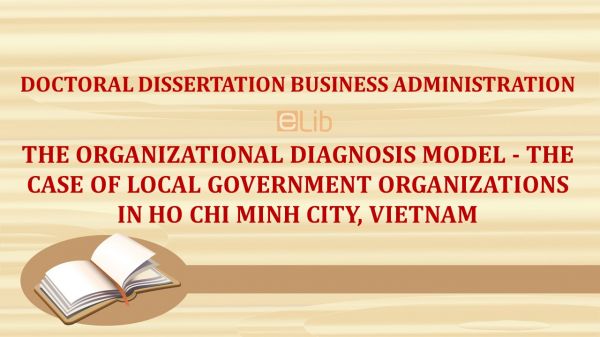Th.D: The organizational diagnosis model - The case of local government organizations in Ho Chi Minh city, Vietnam
The thesis The organizational diagnosis model - The case of local government organizations in Ho Chi Minh city, Vietnam is completed with the objectives of proposing an ODM in the case of LGOs; suggest Consensus component in ODM of LGOs in Vietnam, this is a new factor which has not mentioned in previous researches in ODM theory.
Mục lục nội dung

Th.D: The organizational diagnosis model - The case of local government organizations in Ho Chi Minh city, Vietnam
1. Overview of research
1.1 Organizational diagnosis model
There are a lot of organizational diagnosis model (ODM) among academics and practitioners, such as Kurt Lewin’s Force Field Analysis (1951), Leavitt’s Diamond Model (1965), Open System Theory (1966), Likert’s System Theory (1967), Weisbord’s Six Box Model (1976), Nadler & Tushman’s Congruence Model Framework (1977, 1995), Mc Kinsey Framework (Peter & Waterman, 1981-1982), Tichy’s Technological Political Culture Framework (1983), High-Performance Programming Framework (1984), Individual and Group Behavior Diagnosing Framework – Porras & Anderson, Harrison (1987), Cause and Effect Model – Burke Litwin (1992), Falletta’s Intelligence Model (2008), Semantic Network Model (2014), etc. According to Rosenbaum, More and Steane (2018) Organizational diagnosis theory emphasizes 2 categories, including (i) steps to diagnose and (ii) structural component. Almost all researches mentioned above from the literature review focused on the second category: the structural component. However, the case of enterprises has been studied in this researches.
1.2 Research objectives
Identifying the research framework of ODM in the case of LGOs in HCMC, Vietnam;
Developing the scale measurement of Consensus in LGOs – an aspect of culture - the new component which has not ever mentioned yet in any ODMs from reviewing ODMs theories.
1.3 Research scope
In general, overviewing ODMs we can realize that there are two types of ODMs: ODMs which emphasize the structure components, and ODMs which emphasized the diagnosis process. And in this research we intend to propose an ODM in direction of emphasizing structure components because one of the common characteristics of local government organizations makes pressure to improve their effectiveness to serve the communities, citizens; it means that process to carry out public management activities always change to adapt practical conditions.
1.4 Research methods
This current study uses mixed methods that are carried out by not only the qualitative method but also a quantitative method based on a deductive approach (according to Newman (2000)).
1.5 Research conntributions
In theoretical contributions, we propose an organizational diagnosis model in the case of local government organizations and suggest a Consensus variable in ODM of LGOs in Vietnam, which has not mentioned in previous researches in ODMs theory.
Besides, we developed the scale measurement of Consensus in the ODM of LGOs in Vietnam and fulfilled the measurement scale of Leadership, Relationship, Rewards, Information Management and Communication, Consensus, Inspection and Supervision, Performance in case of LGOs of Vietnam.
2. Content
2.1 Introduction
Organizational diagnosis model
Research objectives
Research questions
Research scope
Research methods
Research contributions
Structure of dissertation
2.2 Literature Review
Introduction
Organizational Diagnosis
Government Organizations
Government Organizational Performance
Organizational Diagnosis Models (ODMs)
Research model and hypotheses
2.3 Methods and Measurements
Introduction
Research process
Qualitative research
Summarize hypotheses of research model
Data collection procedures
Summary of scales
Preliminary research result
2.4 Data Analysis and research results
Introduction
Sample characteristics
Assessment of measurement scales
Discussion the analysis result
2.5 Conclusion
Introduction
Summary of research findings
Contributions and implications
Limitations and further research directions
3. Conclusions
The model framework (after EFA) has 44 variables with 8 components. The confirmatory factoring analysis (CFA) was taken to indicate the validation of measurement model, the scale measurements are reliability (unidimensionality, convergent validity, discriminant validity), Construct Reliability (CR) and Average Variance Extracted (AVE) of scale measurements are supported, Structural Equation Modelling (SEM) result test presented that research model is fit to empirical data and all hypotheses tests are supported. Finally, the framework only has 37 variables with 8 constructs, 7 variables continued to be omitted (Leadership: LE7, LE8, LE9; Relationship: RE4; Rewards: RW1; Attitude towards Change: CA2; Inspection and Supervision: IS5; Performance: PE7). The quantitive test results are presented the effect level of each factor (7 constructs) to Performance of LGOs in HCMC, Vietnam is reasonable in comparison with the practical conditions of Vietnam now.
4. References
4.1 Vietnamese
Nguyễn Đình Thọ, Nguyễn Thị Mai Trang, (2009). Nghiên cứu khoa học trong quản trị kinh doanh. TP.HCM: Nhà xuất bản Thống kê.
Quốc hội Nước Cộng hòa xã hội chủ nghĩa Việt Nam, (2013). Hiến pháp năm 2013 Nước Cộng hòa xã hội chủ nghĩa Việt Nam.
Quốc hội Nước Cộng hòa xã hội chủ nghĩa Việt Nam, (2015). Luật số 77/2015/QH13: Luật Tổ chức chính quyền địa phương.
Quốc hội Nước Cộng hòa xã hội chủ nghĩa Việt Nam, (2003). Luật số 11/2003/QH11: Luật Tổ chức Hội đồng nhân dân và Ủy ban nhân dân.
Thành ủy Thành phố Hồ Chí Minh, (2017). Báo cáo số 182-BC/TU ngày 12/7/2017 của Thành ủy Thành phố Hồ Chí Minh về Kết quả 10 năm thực hiện Chương trình hành động số 35- Ctr/TU của Thành ủy về thực hiện Nghị quyết số 17-NQ/TW Hội nghị lần thứ năm Ban chấp hành Trung ương Khóa X về đẩy mạnh cải cách hành chính, nâng cao hiệu lực, hiệu quả quản lý của bộ máy Nhà nước trên địa bàn Thành phố Hồ Chí Minh.
4.2 English
Albright, J. J. (2008). Confirmatory Factor Analysis using Amos, LISREL, and Mplus. The Trustees of Indiana University, 77. https://doi.org/10.1097/00006199-200605000-00008.
Alderfer, C. P. (1980). The methodology of organizational diagnosis. Professional Psychology, 11(3): 459–468. https://doi.org/10.1037/0735-7028.11.3.459
Alford, J., Hughes, O. (2008.) Public Value Pragmatism as the Next Phase of Public Management. The American Review of Public Administration, 38(2): 130-148.
Balabonienė, I., Večerskienė, G. (2015). The Aspects of Performance Measurement in Public Sector Organization. Procedia - Social and Behavioral Sciences, 213: 314 – 320. (20th International Scientific Conference Economics and Management 2015).
Ben-Arieh D, Chen Z. (2006). Linguistic labels aggregation and consensus measure for autocratic decision-making using group recommendations. IEEE Transactions on Systems Man and Cybernetics, Part A: Systems and Humans; 36(3): 558–569.
--- Nhấn nút TẢI VỀ hoặc XEM ONLINE để tham khảo đầy đủ nội dung Luận án tiến sĩ Quản trị kinh doanh trên trên ---
Tham khảo thêm
- pdf Th.D: Market orientation, corporate social responsibility, and firm performance: The moderation role of relationship marketing orientation
- pdf Luận án TS: Trách nhiệm xã hội của doanh nghiệp, chất lượng mối quan hệ thương hiệu – khách hàng và ý định chuyển đổi thương hiệu trong thị trường hàng tiêu dùng ở Việt Nam
- pdf Luận án TS: Nghiên cứu hoạt động mua lại cổ phiếu tại các công ty trong ngành công nghiệp niêm yết trên thị trường chứng khoán Việt Nam
- pdf Luận án TS: Nghiên cứu các nhân tố ảnh hưởng đến việc triển khai giải pháp quản trị quan hệ khách hàng điện tử tại Hãng Hàng không Quốc gia Việt Nam
- pdf Luận án TS: Mạng lưới quan hệ, đổi mới mô hình kinh doanh và kết quả hoạt động của doanh nghiệp khởi nghiệp tại Việt Nam
- pdf Luận án TS: Hoàn thiện môi trường kinh doanh cho các doanh nghiệp du lịch Việt Nam trong tiến trình toàn cầu hóa
- pdf Luận án TS: Ảnh hưởng trách nhiệm xã hội và sự gắn bó nhân viên đến kết quả hoạt động doanh nghiệp – Nghiên cứu trường hợp các doanh nghiệp phía Nam




